
The Falaq-1 missile is an Iranian made rocket system.

The Falaq-1 missile is an Iranian made rocket system.
The 240 mm unguided surface-to-surface rocket is very similar to the rocket used with the Russian 240 mm (12-round) BM-24 system. The Falaq-1 has a bore of 240 mm, and a weight of 111 kg, with the warhead weighing 50 kg. The 240 mm spin stabilised rockets have a maximum range of 10,000 m and are fitted with a nose-mounted fuze. Propellant used is of the solid double-base type. The rocket is mounted on a 4 × 4 jeep light cross-country vehicle which has six 240 mm rockets in the ready-to-launch position in a frame type launcher on the rear.
The Falaq-1 has a maximum range of 10 km. It weighs 113 kg and carries a 50 kg explosive warhead. [1] Its successor, the Falaq-2, is a 333 mm-diameter rocket. It weighs 255 kg with a 120 kg warhead that holds 60 kg of explosives. [2]
The system was developed in the 1990s by Shahid Bagheri Industrial Group, which is part of the Aerospace Industries Organization. [3]
There is extensive evidence Falaq-1 rockets have been used in the Syrian civil war. [3]
On 26 January 2024, Hezbollah claimed for the first time to have used the Falaq-1 in an attack against the Israel Defense Forces as part of the Israel-Hezbollah conflict during the Israel-Hamas war. [1]
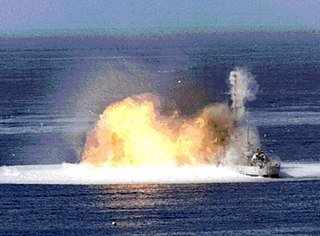
A thermobaric weapon, also called an aerosol bomb, or a vacuum bomb, is a type of explosive munition that works by dispersing an aerosol cloud of gas, liquid or powdered explosive. The fuel is usually a single compound, rather than a mixture of multiple molecules. Many types of thermobaric weapons can be fitted to hand-held launchers, and can also be launched from airplanes.

The AGM-114 Hellfire is an American air-to-surface missile (ASM) first developed for anti-armor use, later developed for precision drone strikes against other target types, especially high-value targets. It was originally developed under the name "Heliborne laser, fire-and-forget missile", which led to the colloquial name "Hellfire" ultimately becoming the missile's formal name. It has a multi-mission, multi-target precision-strike ability and can be launched from multiple air, sea, and ground platforms, including the MQ-1 Predator and MQ-9 Reaper. The Hellfire missile is the primary 100-pound (45 kg) class air-to-ground precision weapon for the armed forces of the United States and many other nations. It has also been fielded on surface platforms in the surface-to-surface and surface-to-air roles.
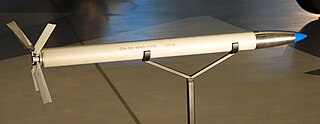
The Mk 4 Folding-Fin Aerial Rocket (FFAR), also known as "Mighty Mouse", is an unguided rocket used by United States military aircraft. It was 2.75 inches (70 mm) in diameter. Designed as an air-to-air weapon for interceptor aircraft to shoot down enemy bombers, it primarily saw service as an air-to-surface weapon. The FFAR has been developed into the modern Hydra 70 series, which is still in service.
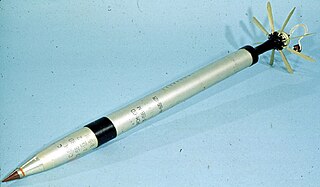
The S-5 is a rocket weapon developed by the Soviet Air Force and used by military aircraft against ground area targets. It is in service with the Russian Aerospace Forces and various export customers. It is based on the R4M, a German design from World War 2.

The 9M14 Malyutka is a manual command to line of sight (MCLOS) wire-guided anti-tank guided missile (ATGM) system developed in the Soviet Union. It was the first man-portable anti-tank guided missile of the Soviet Union and is probably the most widely produced ATGM of all time—with Soviet production peaking at 25,000 missiles a year during the 1960s and 1970s. In addition, copies of the missile have been manufactured under various names by at least six countries.

The BM-27 Uragan is a self-propelled 220 mm multiple rocket launcher designed in the Soviet Union to deliver cluster munitions. The system began its service with the Soviet Army in the late 1970s, and was its first spin and fin stabilized heavy multiple rocket launcher.
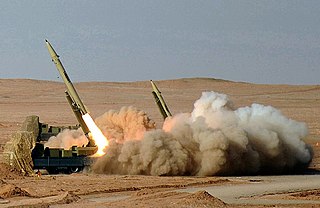
The Fateh-110, also known as NP-110 is an Iranian solid-fueled surface-to-surface ballistic missile produced by Iran's Aerospace Industries Organization since 2002. It is single-stage, road-mobile and can carry a high-explosive warhead of up to 500 kg. Four different versions, the Fateh-110A, 110B, 110D-1 and Fateh-E Mobin were developed with varying accuracy. The latest version, first shown to the public in August 2018 reportedly has a range of 300 km is reportedly more accurate than previous versions.

The Fajr-3 is an Iranian heavy 240 mm intermediate-range multiple-launch artillery rocket (MLRS). The Fajr-3 is a license-built copy, with slight modifications, of a North Korean MLRS called the M-1985. The Fajr-3 was introduced in the 1990s and has since been exported to Hamas and Hezbollah.
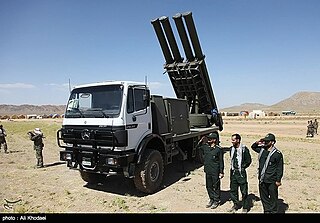
The Fajr-5 is an Iranian 333 mm long-range multiple launch rocket system (MLRS). The Fajr-5 was developed during the 1990s and has since been exported to various armed actors in the Middle East.
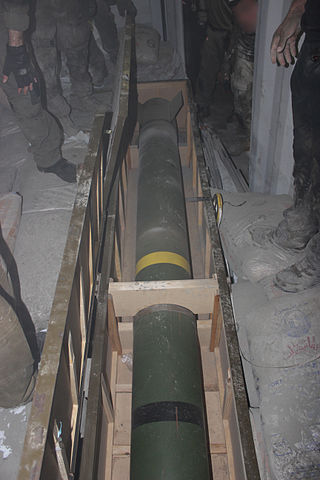
The Khaibar-1, also known as the Khyber-1, M-302, B-302 and the R160 is a Syrian-made 302 mm unguided artillery rocket. It is best known for being used by Hezbollah against targets in northern Israel during the 2006 Lebanon War, and has also been used in the Syrian Civil War. It is a derivative of the Chinese WS-1 rocket.

Hezbollah, a Lebanese Shia Islamist political party and militant group, has an exceptionally strong military wing, thought to be stronger than the Lebanese Army, and equivalent to the armed strength of a medium-sized army. A hybrid force, the group maintains "robust conventional and unconventional military capabilities", and is generally considered to be the most powerful non-state actor in the world.

The Toophan is an Iranian SACLOS anti-tank guided missile reverse-engineered from the American BGM-71 TOW missile. The Toophan 1, an unlicensed copy of the BGM-71A TOW missile, began mass production in 1988 and the Toophan 2, a BGM-71C ITOW variant, was publicly shown in 2000.
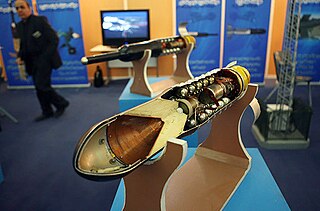
The Saegheh is any of at least eight completely separate Iranian weapons systems: a rocket-propelled grenade (RPG) warhead, an anti-tank guided missile family, a surface-to-surface rocket, a target drone family, an air-to-air missile, a claimed stealth unmanned aerial vehicle, a fighter jet, and an anti-ship cruise missile.

Spike is an Israeli fire-and-forget anti-tank guided missile and anti-personnel missile with a tandem-charge high-explosive anti-tank (HEAT) warhead. As of 2007, it is in its fourth generation. It was developed and designed by the Israeli company Rafael Advanced Defense Systems. It is available in man-portable, vehicle-launched, helicopter-launched and maritime variants.

The YJ-83 is a Chinese subsonic anti-ship cruise missile. It is manufactured by the China Aerospace Science and Industry Corporation Third Academy.

The HESA Karrar is an Iranian jet-powered target drone manufactured by Iran Aircraft Manufacturing Industrial Company (HESA) since 2010. The Karrar is a derivative of the American 1970s-era Beechcraft MQM-107 Streaker target drone, probably incorporating elements from the South African Skua, with hardpoints added for munitions. The Karrar was developed during the Ahmadinejad presidency.
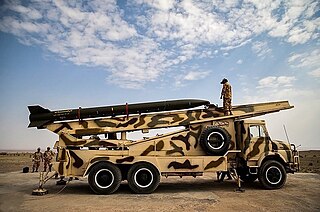
The Naze'at 6-H and Naze'at 10-H/Mushak-120/Iran-130 are two Iranian long-range artillery rockets with ranges of about 100 km. The Naze'at 10-H is larger, more powerful, and has a longer range than the Nazeat 6-H. Like Iran's similar shaped Zelzal rockets, Naze'at rockets do not have a guidance system. Both systems are also widely known without the -H suffix, as the Naze'at 6 and Naze'at 10. The Iranians also have developed another 500 kg version called the Mushak-160 with 160 km range.

The Soviet 240 mm mortar M240 is a 240 millimeter breech loading smoothbore heavy mortar that fires a 130 kilogram projectile. It entered service in 1953.

The Falaq-2 missile is the second generation of Falaq unguided artillery rocket systems. This system was also developed in the 1990s by the Shahid Bagheri Industries, which is part of the Aerospace Industries Organization.

Safir is an Iranian 4x4 multipurpose military vehicle built by Fath Vehicle Industries. The Safir weighs 1.5 tonne and is based on the M38. The jeep can be distinguished from the M38 due to the sharp angled body panels, hood and grille.